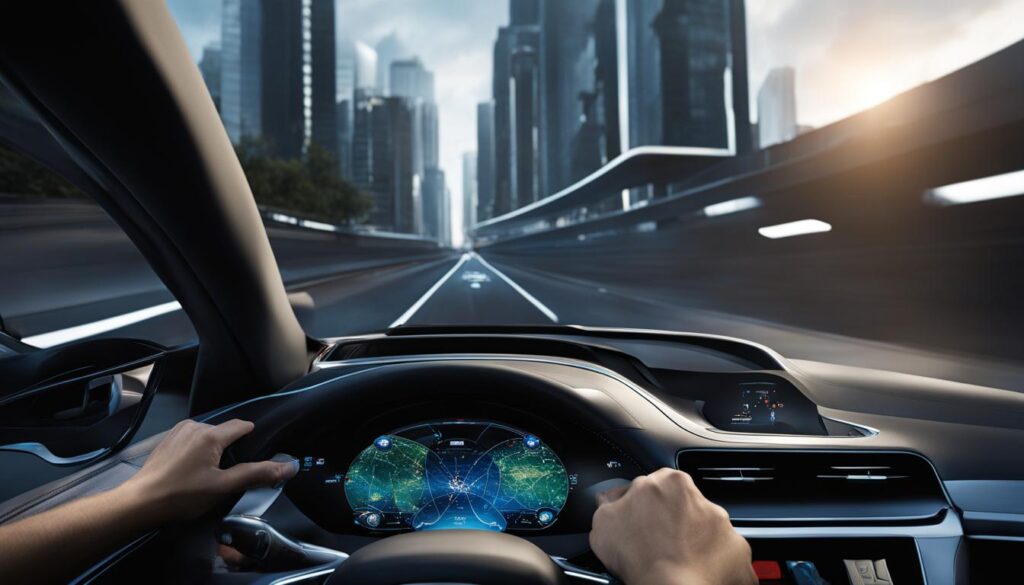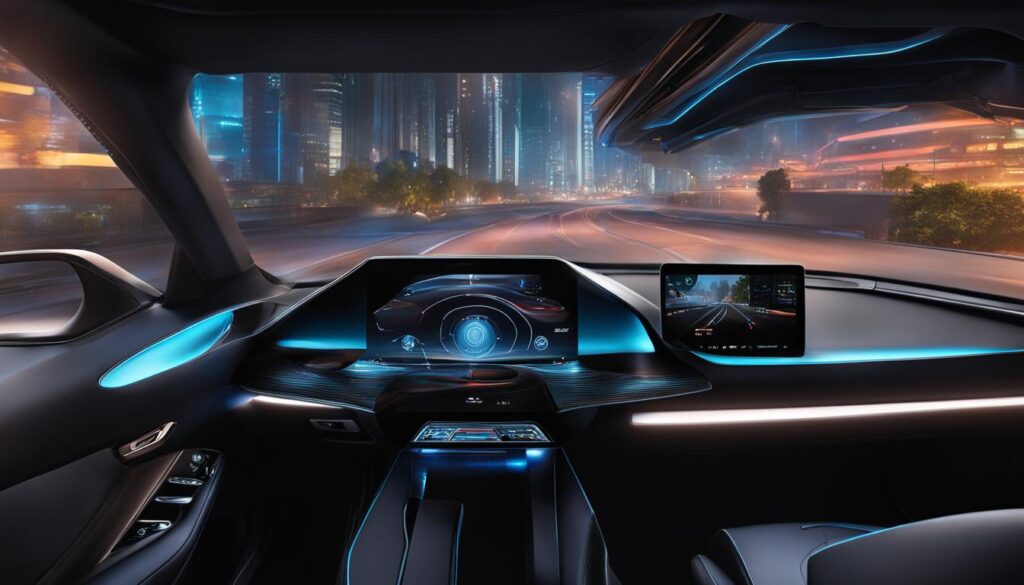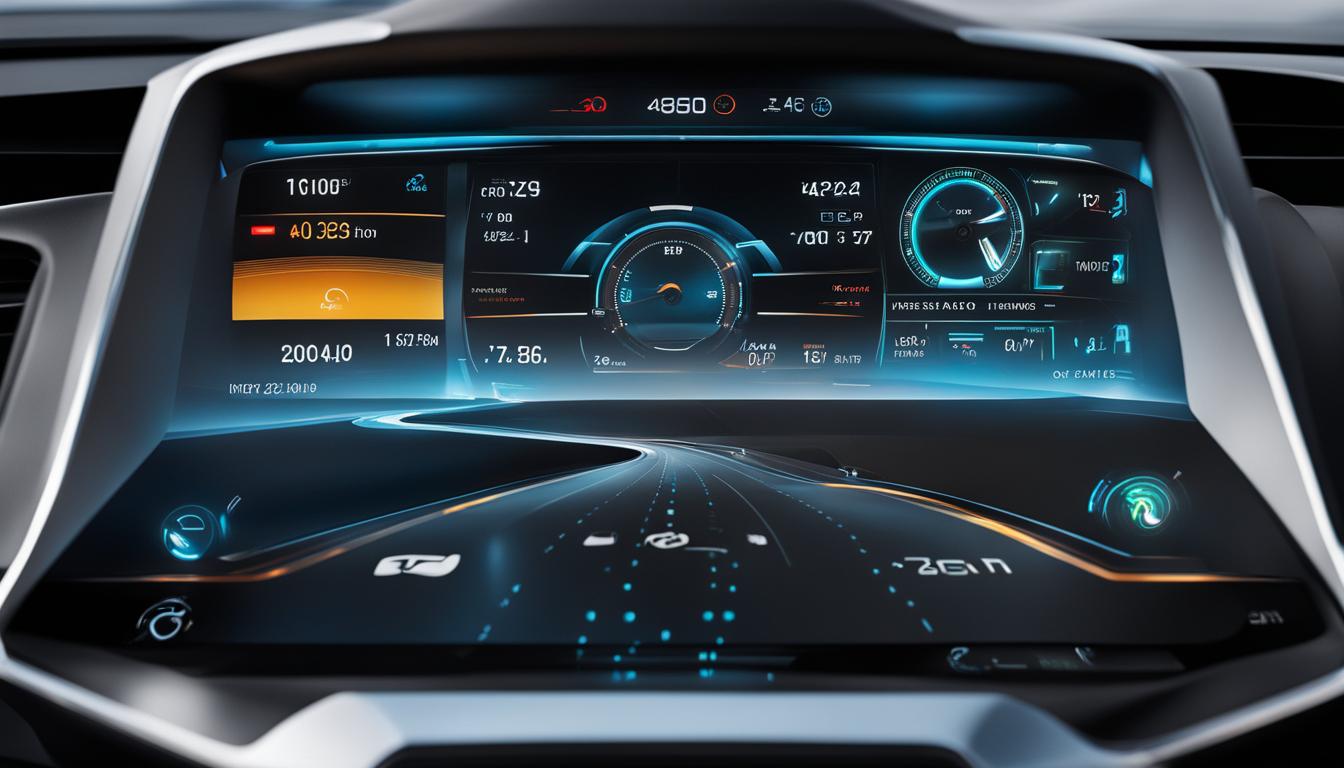Imagine driving down the highway, effortlessly glancing at important information without taking your eyes off the road. With augmented reality heads-up displays (HUDs) in cars, this futuristic concept is becoming a reality.
Leading automakers like Mercedes-Benz and Audi are integrating AR HUD technology into their vehicles, revolutionizing the driving experience.
Mercedes-Benz S-Class is at the forefront of this innovation, offering an AR HUD and other technological upgrades.
Powered by a cutting-edge digital mirror device from Texas Instruments, this AR HUD projects vital information onto your windshield’s 10˚ horizontal and 5˚ vertical aperture. Its resolution of 1.3 megapixels provides crisp and detailed visuals, enhancing your driving experience.
This AR HUD harnesses sensor inputs to display crucial information such as the distance to the car ahead, road markers, and even navigation assistance. Fusing real-world and virtual elements creates an augmented reality experience that enhances safety and situational awareness on the road.
However, implementing AR HUDs requires careful consideration to prevent information overload. Balancing the amount of data displayed and ensuring it doesn’t distract the driver is crucial for an optimal driving experience.
Contents
Key Takeaways:
- AR HUDs are revolutionizing the driving experience by providing vital information directly on the windshield.
- Mercedes-Benz and Audi are leading the way in integrating AR HUD technology into cars.
- AR HUDs enhance safety and situational awareness by displaying real-time information such as distance to the car ahead and navigation assistance.
- Implementing AR HUDs requires careful consideration to avoid information overload and distractions for the driver.
- AR HUDs have the potential to revolutionize the way we drive, making it safer and more convenient.
How Augmented Reality HUDs Improve Driver Safety
Augmented reality (AR) head-up displays (HUDs) are shaping the future of connected vehicles, revolutionizing the driving experience with safer and more inclusive transportation.
By projecting transparent digital images onto the windshield, AR HUDs merge seamlessly with the driver’s view of the road, enhancing situational awareness and reducing distractions.
Advancements in heads-up display technology have paved the way for holographic displays and 3D AR HUDs. These cutting-edge innovations offer increased depth perception and enable real-time projection of virtual objects onto the windshield.
As a result, drivers can receive crucial information regarding road obstacles, navigation guidance, and vehicle performance without diverting their attention away from the road.
“AR HUDs have the potential to greatly improve driver safety by reducing eye strain and driving stress levels. By seamlessly integrating relevant information into the driver’s field of view, AR HUDs allow for quicker reaction times and better anticipation of road conditions.”
The immersive nature of AR HUDs offers numerous benefits to drivers. By eliminating the need for constant shifting between the instrument cluster and the road, drivers experience reduced eye strain and mental fatigue.
The constant availability of vital information projected on the windshield keeps the driver focused on the road, preventing them from missing critical details.
Furthermore, AR HUDs enhance driver comfort by providing a dynamic and personalized display. Drivers can customize the information displayed on the windshield according to their preferences, ensuring that only relevant data is presented.
Also read: Best Tool for Creating Augmented Reality Experiences
This level of customization improves the driving experience and empowers drivers with the knowledge they need to make informed decisions on the road.
However, it is essential to comprehensively address AR HUDs’ impact on driver safety. Studies and research are underway to analyze AR HUDs’ potential drawbacks and limitations.
Factors such as the optimal placement of content on the windshield, potential distractions caused by the augmented reality elements, and ensuring road safety and security are areas of ongoing exploration.
The Future of Augmented Reality in Automobiles
Integrating augmented reality heads-up displays represents a significant shift in automotive technology.
AR HUDs will become increasingly sophisticated as technology evolves, offering intuitive gesture controls, enhanced driver assistance systems, and seamless integration with autonomous vehicles.
| AR Heads-Up Display Benefits | Heads-Up Display Features for Cars | Heads-Up Display Technology |
|---|---|---|
| Improved driver safety and awareness | Customizable information display | Real-time projection of virtual objects |
| Reduced eye strain and mental fatigue | Navigation guidance and road assistance | Integration with advanced driver assistance systems (ADAS) |
| Enhanced driving experience | Gesture control and intuitive interfaces | Seamless integration with autonomous driving |
The commercialization of AR HUDs is underway, with companies like Envisics leading in the field. Envisics, a UK-based holographic company, has secured significant funding to bring its AR HUD technology to market. Additionally, major automakers such as General Motors, BMW, Stellantis, Hyundai, and SAIC Motor are actively exploring the integration of AR HUDs in their vehicles.
Augmented reality HUDs have the potential to transform the driving experience, placing vital information directly in the driver’s line of sight.
AR HUDs represent a critical technological advancement in the automotive industry by improving driver safety, reducing distractions, and increasing awareness.
Also read: Augmented Reality Surgery Training Uses
Challenges in Implementing AR HUDs
Implementing augmented reality heads-up displays (AR HUDs) in cars has its fair share of challenges. Let’s explore some key hurdles that must be overcome for successful implementation.
Creating a Multifocal Display with a Large Viewing Area
One of the main challenges is designing a multifocal display that offers a large viewing area without compromising the driver’s field of view. The display should seamlessly integrate with the windshield while providing precise and crisp information.
Optimal Positioning on the Windshield
The positioning of the AR HUD on the windshield plays a crucial role in ensuring minimal invasiveness while driving. It should be strategically placed to provide the necessary information without obstructing the driver’s view of the road.
Placement of Content and Hazard Identification
Another challenge is determining the best way to present content on the windshield. The placement of information needs to be intuitive and easy to comprehend while also considering identifying road hazards and potential dangers.
An Inclusive Strategy for Different Individuals
Developing AR HUD technology that caters to the needs of visually and movement-impaired individuals is essential. An inclusive strategy should be implemented to ensure that everyone can benefit from car heads-up display features.
Secure Information Management and Legislative Requirements
With the integration of AR technology comes the need for secure information management. Safeguarding sensitive data from cyber threats and ensuring compliance with legislative requirements are vital aspects that must be addressed.

Commercialization of AR HUDs in Cars
Envisics, a UK-based holographic company, is making significant strides in commercializing augmented reality heads-up displays (AR HUDs) for cars. With a recent Series C funding round raising $100 million, Envisics is poised to revolutionize how drivers interact with their vehicles.
General Motors has confirmed that Envisics’ second-generation AR HUD displays will be available in the electric Cadillac Lyriq, further highlighting the company’s growing influence in the automotive industry.
Moreover, other major automakers such as Stellantis, Hyundai, and SAIC Motor are potential partners, indicating a high interest in integrating AR HUD technology into their vehicles.
The adoption of AR HUDs represents a significant step in improving driver safety and convenience. By projecting important information directly onto the windshield, AR HUDs allow drivers to access crucial details without taking their eyes off the road.
This technology enhances situational awareness, reduces distractions, and creates a safer driving experience.
BMW has also showcased its commitment to AR HUDs by unveiling concept cars equipped with this cutting-edge technology. As the automotive industry continues to advance in areas such as advanced driver assistance systems (ADAS) and autonomous driving, AR HUDs are becoming an integral part of the future of automobiles.
Benefits of AR HUDs in Cars
The introduction of AR HUDs in cars offers numerous benefits for both drivers and passengers:
- Enhanced Safety: By displaying essential information directly in the driver’s line of sight, AR HUDs minimize the need for distractions and help drivers stay focused on the road.
- Improved Navigation: AR HUDs provide intuitive and real-time navigation assistance, ensuring drivers can easily follow directions without taking their eyes off the road.
- Increased Convenience: With AR HUDs, drivers can effortlessly access vital vehicle information, such as speed and fuel levels, promoting a more convenient driving experience.
- Reduced Eye Strain: By constantly eliminating the need to shift focus between the road and the dashboard, AR HUDs help minimize eye strain and fatigue during long drives.
As automakers like Envisics and General Motors pave the way, the commercialization of AR HUDs marks an exciting development for the automotive industry.
With their potential to transform how we interact with cars, AR HUDs have the power to redefine the driving experience as we know it.
| Automaker | AR HUD Integration |
|---|---|
| Envisics | General Motors (Cadillac Lyriq) |
| BMW | Concept Cars |
| Stellaris | Potential Partner |
| Hyundai | Potential Partner |
| SAIC Motor | Potential Partner |

Conclusion
Augmented reality heads-up displays (AR HUDs) have emerged as a transformative technology in the automotive industry, revolutionizing our drive.
By harnessing augmented reality, these innovative displays provide real-time information on the windshield, enhancing the driving experience and improving safety.
AR HUDs are pivotal in reducing distractions and keeping the driver’s attention on the road. By projecting essential information directly within the driver’s line of sight, they eliminate the need to look away or divert attention to secondary devices.
This seamless integration of information promotes safer driving practices and helps prevent accidents caused by distracted driving.
While implementing AR HUDs presents challenges, such as creating a multifocal display and identifying optimal content placement, significant strides have been made in their development.
Companies like Envisics and General Motors are at the forefront of commercializing AR HUD technology, paving the way for widespread adoption and integration across various vehicle models and brands.
Looking ahead, the future of augmented reality in heads-up displays looks promising. As the technology advances, we can expect further refinements, increased compatibility with advanced driver assistance systems, and enhanced user experiences.
Augmented reality heads-up displays are poised to transform how we drive, offering a safer, more connected, and immersive driving environment.
FAQ
What is a heads-up display (HUD) for cars?
A heads-up display (HUD) for cars is a technology that projects transparent digital images onto the windshield, merging with the driver’s view of the road. It provides real-time information without the driver taking their eyes off the road.
How do augmented reality (AR) HUDs improve driver safety?
AR HUDs improve driver safety by reducing distractions and keeping the driver’s attention on the road. They provide real-time information on the windshield, enhancing the driver’s awareness of road obstacles and reducing eye strain and driving stress levels.
What are the challenges in implementing AR HUDs?
Implementing AR HUDs comes with challenges, such as creating a multifocal display with a large viewing area without compromising the field of view. The optimal positioning on the windshield and minimal invasiveness while driving are crucial. The placement of content on the windshield and the identification of hazards on the road need further study.
What are the benefits of heads-up display features for cars?
Heads-up display features for cars provide benefits such as reducing distractions, improving driver safety, enhancing the driving experience, and keeping the driver’s attention on the road by providing real-time information without the driver having to take their eyes off the road.
How are AR HUDs being commercialized in cars?
AR HUDs are being commercialized in cars through partnerships between automakers and companies specializing in AR HUD technology. For example, Envisics, a UK-based holographic company, has raised significant funding to commercialize its AR HUD technology. General Motors has confirmed they will incorporate Envisics’ AR HUD displays in their electric Cadillac Lyriq.




